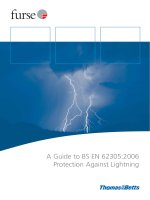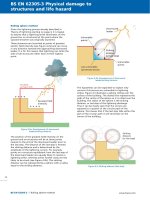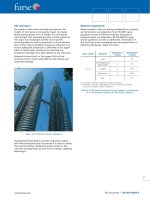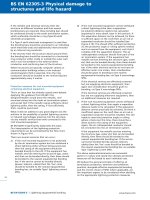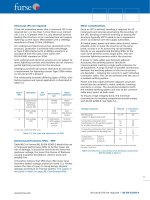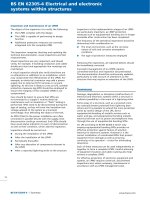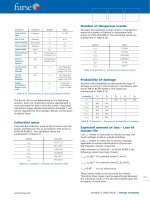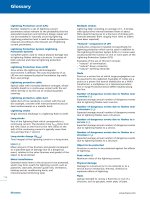Bsi bs en 01263 2 2014
Bạn đang xem bản rút gọn của tài liệu. Xem và tải ngay bản đầy đủ của tài liệu tại đây (1.09 MB, 18 trang )
BS EN 1263-2:2014
BSI Standards Publication
Temporary works equipment —
Safety nets
Part 2: Safety requirements for the
positioning limits
BS EN 1263-2:2014
BRITISH STANDARD
National foreword
This British Standard is the UK implementation of EN 1263-2:2014. It
supersedes BS EN 1263-2:2002 which is withdrawn.
The UK participation in its preparation was entrusted to Technical
Committee B/514/27, Nets and sheets.
A list of organizations represented on this committee can be
obtained on request to its secretary.
This publication does not purport to include all the necessary
provisions of a contract. Users are responsible for its correct
application.
© The British Standards Institution 2014.
Published by BSI Standards Limited 2014
ISBN 978 0 580 80842 5
ICS 13.340.60
Compliance with a British Standard cannot confer immunity from
legal obligations.
This British Standard was published under the authority of the
Standards Policy and Strategy Committee on 31 December 2014.
Amendments/corrigenda issued since publication
Date
Text affected
BS EN 1263-2:2014
EN 1263-2
EUROPEAN STANDARD
NORME EUROPÉENNE
EUROPÄISCHE NORM
December 2014
ICS 13.340.60
Supersedes EN 1263-2:2002
English Version
Temporary works equipment - Safety nets - Part 2: Safety
requirements for the positioning limits
Équipement temporaires de chantiers - Filets de sécurité Partie 2 : Exigences de sécurité concernant les limites de
montage
Temporäre Konstruktionen für Bauwerke - Schutznetze
(Sicherheitsnetze) - Teil 2: Sicherheitstechnische
Anforderungen für die Errichtung von Schutznetzen
This European Standard was approved by CEN on 8 November 2014.
CEN members are bound to comply with the CEN/CENELEC Internal Regulations which stipulate the conditions for giving this European
Standard the status of a national standard without any alteration. Up-to-date lists and bibliographical references concerning such national
standards may be obtained on application to the CEN-CENELEC Management Centre or to any CEN member.
This European Standard exists in three official versions (English, French, German). A version in any other language made by translation
under the responsibility of a CEN member into its own language and notified to the CEN-CENELEC Management Centre has the same
status as the official versions.
CEN members are the national standards bodies of Austria, Belgium, Bulgaria, Croatia, Cyprus, Czech Republic, Denmark, Estonia,
Finland, Former Yugoslav Republic of Macedonia, France, Germany, Greece, Hungary, Iceland, Ireland, Italy, Latvia, Lithuania,
Luxembourg, Malta, Netherlands, Norway, Poland, Portugal, Romania, Slovakia, Slovenia, Spain, Sweden, Switzerland, Turkey and United
Kingdom.
EUROPEAN COMMITTEE FOR STANDARDIZATION
COMITÉ EUROPÉEN DE NORMALISATION
EUROPÄISCHES KOMITEE FÜR NORMUNG
CEN-CENELEC Management Centre: Avenue Marnix 17, B-1000 Brussels
© 2014 CEN
All rights of exploitation in any form and by any means reserved
worldwide for CEN national Members.
Ref. No. EN 1263-2:2014 E
BS EN 1263-2:2014
EN 1263-2:2014 (E)
Contents
Page
Foreword ..............................................................................................................................................................3
1
Scope ......................................................................................................................................................4
2
Normative references ............................................................................................................................4
3
Terms and definitions ...........................................................................................................................4
4
4.1
4.2
4.3
Safety requirements ..............................................................................................................................4
Instruction manual .................................................................................................................................4
Fall height ...............................................................................................................................................4
Catching width .......................................................................................................................................5
5
5.1
5.2
5.3
5.4
Positioning of system S safety nets ....................................................................................................7
Size of system S safety nets.................................................................................................................7
Positioning fixings .................................................................................................................................7
Safety net linkage ..................................................................................................................................8
Deformation of the safety net ...............................................................................................................8
6
6.1
6.2
6.3
Positioning of system T safety nets ....................................................................................................9
Positioning .............................................................................................................................................9
Safety net linkage ..................................................................................................................................9
Support frame positioning ................................................................................................................. 10
7
Positioning of system U safety nets ................................................................................................. 10
8
8.1
8.2
8.3
Positioning of system V safety nets ................................................................................................. 10
Position of the upper edge of the safety net .................................................................................... 10
Safety net linkage ............................................................................................................................... 11
Positioning .......................................................................................................................................... 11
Annex A (informative) A-deviations............................................................................................................... 12
Bibliography ..................................................................................................................................................... 13
2
BS EN 1263-2:2014
EN 1263-2:2014 (E)
Foreword
This document (EN 1263-2:2014) has been prepared by Technical Committee CEN/TC 53 “Temporary works
equipment”, the secretariat of which is held by DIN.
This European Standard shall be given the status of a national standard, either by publication of an identical
text or by endorsement, at the latest by June 2015 and conflicting national standards shall be withdrawn at the
latest by June 2015.
Attention is drawn to the possibility that some of the elements of this document may be the subject of patent
rights. CEN [and/or CENELEC] shall not be held responsible for identifying any or all such patent rights.
This document supersedes EN 1263-2:2002.
This European Standard is one of a series of standards as listed below:
—
EN 1263-1, Temporary works equipment — Safety nets — Part 1: Safety requirements, test methods
—
EN 1263-2, Temporary works equipment — Safety nets — Part 2: Safety requirements for the positioning
limits
The significant changes incorporated in this revision are:
a)
revision of Figures 1, 2, 4, and 5;
b)
complete editorial revision.
According to the CEN-CENELEC Internal Regulations, the national standards organizations of the following
countries are bound to implement this European Standard: Austria, Belgium, Bulgaria, Croatia, Cyprus, Czech
Republic, Denmark, Estonia, Finland, Former Yugoslav Republic of Macedonia, France, Germany, Greece,
Hungary, Iceland, Ireland, Italy, Latvia, Lithuania, Luxembourg, Malta, Netherlands, Norway, Poland, Portugal,
Romania, Slovakia, Slovenia, Spain, Sweden, Switzerland, Turkey and the United Kingdom.
3
BS EN 1263-2:2014
EN 1263-2:2014 (E)
1
Scope
This European Standard specifies safety requirements for the positioning of safety nets in accordance with the
manufacturer's instruction manual and with the product specifications and for the testing of system S, system
T, system U and system V safety nets in accordance with EN 1263-1.
2
Small safety nets of system S according to EN 1263-1 (less than 35 m and 5,0 m on the shortest side) are
not dealt with in this European Standard.
2
Normative references
The following documents, in whole or in part, are normatively referenced in this document and are
indispensable for its application. For dated references, only the edition cited applies. For undated references,
the latest edition of the referenced document (including any amendments) applies.
EN 1263-1:2014, Temporary works equipment — Safety nets — Part 1: Safety requirements, test methods
3
Terms and definitions
For the purposes of this document, the terms and definitions given in EN 1263-1:2014 apply.
4
4.1
Safety requirements
Instruction manual
For the use and application of safety nets an instruction manual (guidance) in accordance with
EN 1263-1:2014, Clause 9 shall be included with each consignment of safety net. This instruction manual
shall be available in the language of the user. It shall contain at least the following information:
—
required anchorage forces;
—
maximum fall height;
—
minimum catching width;
—
safety net linkage;
—
minimum distance below the safety net;
—
storage;
—
examination;
—
replacement.
In addition to these instructions, special installation instructions shall be followed according to the specific
application of the net.
4.2
Fall height
The fall heights Hi, He and Hr are defined in Table 1.
4
BS EN 1263-2:2014
EN 1263-2:2014 (E)
Table 1 — Definitions of fall heights
Figure
Definition
Comment
Hi
1
The vertical distance between the
working level being safeguarded
and the safety net
The maximum permissible fall height into a
safety net is 6 m from the working level, which
means that the maximum nominal fall height
from the centre of gravity of a person is 7 m.
He
1, 2 and
5
The vertical distance between the
edge of a working level being
safeguarded and the safety net
This dimension is to be used to calculate the
horizontal projection of the safety net beyond
the working level above it. See Table 2.
Hr
1
The vertical distance between the
working level being safeguarded
and the 2 m wide border edge of
the safety net.
Safety nets are less able to carry an impact load
near the edges of the net. Therefore, the vertical
distance at this point shall not exceed 3,0 m.
Safety nets should be erected as close as possible below the working level. Each of the fall heights Hi and He
shall not exceed 6,0 m (see Figure 1, Figure 2 and Figure 5).
In addition to this, the reduced fall height Hr within 2 m of the border shall not exceed 3,0 m (see Figure 1).
4.3
Catching width
The catching width b is the horizontal distance between the edge of the working area and the edge of the
safety net (see Figure 1 and Figure 2).
Dependent on the fall height, the catching width b of the safety net shall not be less than the values given in
Table 2.
Table 2 — Fall heights and required catching widths
Fall height He
≤
1,0 m
≤
3,0 m
≤
6,0 m
Catching width b
≥
2,0 m
≥
2,5 m
≥
3,0 m
5
BS EN 1263-2:2014
EN 1263-2:2014 (E)
Dimensions in centimetres
Key
1
safety net
Figure 1 — Fall heights and required catching widths of working areas inclined between 0° and 20°
If the working area is inclined by more than 20°:
—
the catching width b shall be at least 3,0 m;
—
the distance t between the outermost working point and the lowest point of the edge of the safety net shall
not exceed 3,0 m (see Figure 2).
6
BS EN 1263-2:2014
EN 1263-2:2014 (E)
Dimensions in centimetres
Key
1
safety net
2
lowest point of the edge of the safety net
Figure 2 — Fall heights and required catching widths of working areas inclined by more than 20°
5
5.1
Positioning of system S safety nets
Size of system S safety nets
2
For the positioning of system S safety nets the smallest size shall be at least 35 m . For rectangular safety
nets the length of the shortest side shall be at least 5,0 m.
2
Small safety nets (less than 35 m and 5,0 m on the shortest side) are not part of this standard and should be
determined by national regulations where applicable.
5.2
Positioning fixings
System S safety nets shall be positioned with tie ropes or other devices on anchorage points capable of
bearing the characteristic load. For attachment devices other than tie ropes a safety factor of 2 shall be used.
The distance between the anchorage points shall be less than 2,5 m.
To calculate each anchorage point, the characteristic load P used shall be at least 6 kN with the fall height
being 6,0 m. The assumed angle of this load shall be α = 45° (see Figure 3). For the calculation of the
supporting framework only three characteristic loads of 4 kN, 6 kN and 4 kN shall be considered applied in the
most unfavourable way (see Figure 3).
7
BS EN 1263-2:2014
EN 1263-2:2014 (E)
Figure 3 — Examples of characteristic loads at the anchorage points
5.3
Safety net linkage
For the linkage of single safety nets, coupling ropes in accordance with EN 1263-1 shall be used. The linkage
shall be made in such a way that gaps greater than 100 mm do not develop between the edges of the nets.
When system S safety nets are linked by overlapping, the minimum overlap shall be at least 2,0 m.
5.4
Deformation of the safety net
The maximum deformation of the safety net when rigged according to the test conditions given in
EN 1263-1:2014, Clause 7, is shown in Figure 4.
NOTE
8
Safety distances below the deformed safety net are not covered by this European Standard.
BS EN 1263-2:2014
EN 1263-2:2014 (E)
Key
l
span of the safety net (smallest side)
h
vertical distance between anchorage point of the safety net and the working level above
Hi
vertical distance between the safety net and the working level above
f0
deformation caused by the self-weight of the safety net
fmax
maximum deformation caused by the self-weight of the safety net plus dynamic load
The curves only apply if:
≤ 0,1 · l
—
f0
—
Hi = h + f 0
≤ 6,0 m
Figure 4 — Maximum deformation of the safety net
6
6.1
Positioning of system T safety nets
Positioning
System T safety nets shall be erected according to the instruction manual supplied with the consignment.
6.2
Safety net linkage
For the linkage of single safety nets, coupling ropes in accordance with EN 1263-1 shall be used. The linkage
shall be made in such a way that gaps greater than 100 mm do not develop between the edges of the nets.
When system T safety nets are linked by overlapping, the minimum overlap shall be 0,75 m.
9
BS EN 1263-2:2014
EN 1263-2:2014 (E)
6.3
Support frame positioning
The support frame shall be positioned so that the person falling into the safety net does not impact with the
frame.
7
Positioning of system U safety nets
For positioning limits of system U safety nets, see EN 13374.
8
8.1
Positioning of system V safety nets
Position of the upper edge of the safety net
The upper edge of the safety net shall be located at least 1,0 m above the working level (see Figure 5).
Dimensions in centimetres
Figure 5 — Position of the upper edge of the safety net
10
BS EN 1263-2:2014
EN 1263-2:2014 (E)
8.2
Safety net linkage
For the linkage of single safety nets, coupling ropes in accordance with EN 1263-1 shall be used. The linkage
shall be made in such a way that gaps greater than 100 mm do not develop between the edges of the nets.
For system V safety nets, overlapping shall not be used.
8.3
Positioning
The safety net shall be attached to “gallow” type system supports at its upper edge and to the building or
supporting framework at its lower edge.
For the positioning of the net, the following points shall be taken into account:
—
the distance between any two top supports shall not exceed 5,0 m;
—
the supports shall be secured against turning;
—
the distance between the bottom edge anchorage devices for the attachment of the net to the building
shall not exceed 0,50 m (see Figure 6);
—
the distance between the anchorage points and the edge of the building shall be at least 0,1 m (see
Figure 6);
Dimensions in centimetres
Figure 6 — Anchorage points for the attachment of the lower edge of the safety net to the building by
a border rope
—
the upper edge of the safety net shall be attached to a “gallow” type support by a tie rope (see Figure 7).
Figure 7 — Attachment of the upper edge of the safety net to a “gallow” type support with a tie rope
11
BS EN 1263-2:2014
EN 1263-2:2014 (E)
Annex A
(informative)
A-deviations
A-deviation: National deviation due to regulations, the alteration of which is for the time being outside the
competence of the CEN-CENELEC national member.
This European Standard does not fall under any Directive of the EU.
In the relevant CEN-CENELEC countries these A-deviations are valid instead of the provisions of the
European Standard until they have been removed.
Clause
Deviation
Denmark
4.3 Catching
width,
Figure 1
Danish Ministry of Labour, Order on the conditions of construction sites and similar work
places (Order 589, 22 June 2001, Clauses 19 and 21.1)
4.3 Catching
width,
Figure 2
Danish Ministry of Labour, Order on the conditions of construction sites and similar work
places (Order 589, 22 June 2001, Clauses 19 and 21.1)
Clause 6
Positioning of
system T
safety nets
Danish Ministry of Labour, Order on the conditions of construction sites and similar work
places (Order 589, 22 June 2001, Clauses 19 and 21.1)
Clause 8
Positioning of
system V
safety nets
Danish Ministry of Labour, Order on the conditions of construction sites and similar work
places (Order 589, 22 June 2001, Clauses 19 and 21.1).
12
BS EN 1263-2:2014
EN 1263-2:2014 (E)
Bibliography
EN 13374, Temporary edge protection systems — Product specification — Test methods
13
This page deliberately left blank
This page deliberately left blank
NO COPYING WITHOUT BSI PERMISSION EXCEPT AS PERMITTED BY COPYRIGHT LAW
British Standards Institution (BSI)
BSI is the national body responsible for preparing British Standards and other
standards-related publications, information and services.
BSI is incorporated by Royal Charter. British Standards and other standardization
products are published by BSI Standards Limited.
About us
Revisions
We bring together business, industry, government, consumers, innovators
and others to shape their combined experience and expertise into standards
-based solutions.
Our British Standards and other publications are updated by amendment or revision.
The knowledge embodied in our standards has been carefully assembled in
a dependable format and refined through our open consultation process.
Organizations of all sizes and across all sectors choose standards to help
them achieve their goals.
Information on standards
We can provide you with the knowledge that your organization needs
to succeed. Find out more about British Standards by visiting our website at
bsigroup.com/standards or contacting our Customer Services team or
Knowledge Centre.
Buying standards
You can buy and download PDF versions of BSI publications, including British
and adopted European and international standards, through our website at
bsigroup.com/shop, where hard copies can also be purchased.
If you need international and foreign standards from other Standards Development
Organizations, hard copies can be ordered from our Customer Services team.
Subscriptions
Our range of subscription services are designed to make using standards
easier for you. For further information on our subscription products go to
bsigroup.com/subscriptions.
With British Standards Online (BSOL) you’ll have instant access to over 55,000
British and adopted European and international standards from your desktop.
It’s available 24/7 and is refreshed daily so you’ll always be up to date.
You can keep in touch with standards developments and receive substantial
discounts on the purchase price of standards, both in single copy and subscription
format, by becoming a BSI Subscribing Member.
PLUS is an updating service exclusive to BSI Subscribing Members. You will
automatically receive the latest hard copy of your standards when they’re
revised or replaced.
To find out more about becoming a BSI Subscribing Member and the benefits
of membership, please visit bsigroup.com/shop.
With a Multi-User Network Licence (MUNL) you are able to host standards
publications on your intranet. Licences can cover as few or as many users as you
wish. With updates supplied as soon as they’re available, you can be sure your
documentation is current. For further information, email
BSI Group Headquarters
389 Chiswick High Road London W4 4AL UK
We continually improve the quality of our products and services to benefit your
business. If you find an inaccuracy or ambiguity within a British Standard or other
BSI publication please inform the Knowledge Centre.
Copyright
All the data, software and documentation set out in all British Standards and
other BSI publications are the property of and copyrighted by BSI, or some person
or entity that owns copyright in the information used (such as the international
standardization bodies) and has formally licensed such information to BSI for
commercial publication and use. Except as permitted under the Copyright, Designs
and Patents Act 1988 no extract may be reproduced, stored in a retrieval system
or transmitted in any form or by any means – electronic, photocopying, recording
or otherwise – without prior written permission from BSI. Details and advice can
be obtained from the Copyright & Licensing Department.
Useful Contacts:
Customer Services
Tel: +44 845 086 9001
Email (orders):
Email (enquiries):
Subscriptions
Tel: +44 845 086 9001
Email:
Knowledge Centre
Tel: +44 20 8996 7004
Email:
Copyright & Licensing
Tel: +44 20 8996 7070
Email:
